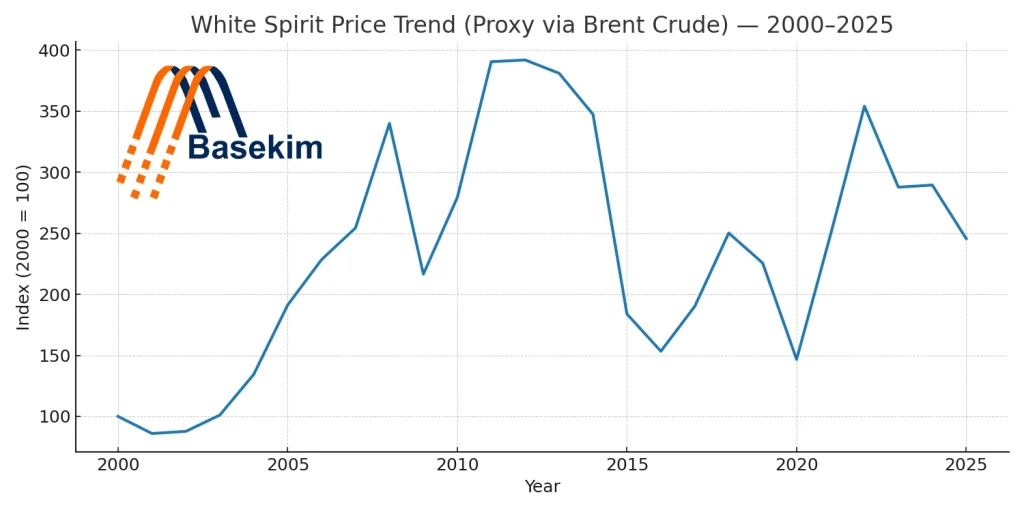
White Spirit—also known as mineral spirits or Stoddard solvent—is a petroleum-derived solvent widely used in paints, coatings, cleaning applications, and degreasing processes. Understanding White Spirit Price Trends is crucial for manufacturers, distributors, and traders who rely on stable procurement costs. Between 2000 and 2025, white spirit prices have closely followed the movements of global crude oil markets, particularly Brent crude, which serves as a key feedstock reference.
The Link Between White Spirit Prices and Crude Oil
Since white spirit is refined from petroleum, its price is directly influenced by fluctuations in crude oil benchmarks. Brent crude oil prices—tracked from 2000 to 2025—showed significant volatility, with notable peaks in 2008, 2012–2014, and 2022, and sharp declines during global recessions or reduced demand periods such as 2009, 2015, and the early 2020 pandemic shock.
When crude prices rise, refining costs and feedstock expenses increase, driving white spirit market prices upward. Conversely, when crude prices fall, solvent producers often adjust their selling prices downward, making white spirit more affordable for industrial users.
Key White Spirit Price Trend Milestones (2000–2025)
2000–2004: Stable and relatively low prices, with white spirit remaining affordable due to moderate crude oil costs.
2005–2008: Strong upward trend as crude oil reached record highs before the 2008 financial crisis.
White Spirit Price 2009: Sharp decline following the recession, offering temporary relief for solvent buyers.
2010–2014: Sustained high prices driven by strong global demand and geopolitical tensions affecting oil supply.
2015–2016: Significant drop in crude oil prices, which reflected quickly in lower white spirit prices.
2017–2019: Gradual recovery and price stabilization.
White Spirit Price 2020: Pandemic-related demand collapse caused prices to fall sharply.
2021–2022: Rapid rebound due to supply chain disruptions and strong post-pandemic demand.
2023–2025: Moderate corrections, with market conditions stabilizing but still sensitive to geopolitical factors.
Global Demand Drivers
The demand for white spirit is influenced by several industries:
Paints & Coatings: Still the largest consumer segment, particularly in construction and automotive sectors.
Industrial Cleaning: Growth in manufacturing output directly boosts solvent demand.
Chemical Processing: Used as a raw material or process solvent in various industries.
Market Outlook white spirit price
Between 2025 and beyond, white spirit market trends will depend on:
Crude Oil Price Forecasts – as feedstock remains the key cost driver.
Environmental Regulations – stricter VOC limits may impact solvent formulations and demand.
Substitute Products – water-based and bio-based solvents may gradually capture market share.
Regional Demand Shifts – growth in Asia-Pacific manufacturing could drive higher consumption.
Conclusion
The White Spirit Price Trends from 2000 to 2025 show a clear correlation with Brent crude oil fluctuations. By tracking crude oil market movements, industry players can better forecast procurement costs and manage inventory strategies. For companies in the coatings, cleaning, and chemical sectors, staying informed about historical price analysis helps ensure competitive pricing and cost-efficient operations.
White Spirit Price & Market Trend Analysis (2000–2025)
Comprehensive report and data table showing the historical price index of White Spirit from 2000 to 2025, key market events influencing price trends, and insights into global market dynamics. Includes analysis of crude oil correlations, economic impacts, and demand drivers across major industries.
